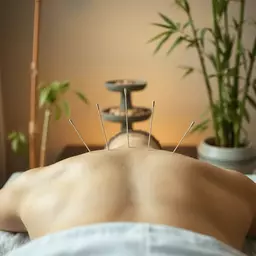Effectiveness
Clinical trials show up to 60% improvement in chronic pain patients.
Statistically significant reduction in pain intensity reported.
Subscribe to get the latest insights and updates straight to your inbox.
Posted on: 2025-06-06
By: Kaiya Whitmore
As the interest in holistic health solutions rises, the significance of acupuncture in effective pain management is becoming clearer. With its deep-rooted history and growing acceptance in modern healthcare, acupuncture presents a compelling alternative to traditional pain relief methods. This article sheds light on how acupuncture can transform pain management practices worldwide.
Acupuncture has demonstrated notable effectiveness in pain management, evidenced by various research findings and cultural perspectives. Below are key statistics and comparisons that encapsulate its role in holistic health solutions.
Clinical trials show up to 60% improvement in chronic pain patients.
Statistically significant reduction in pain intensity reported.
Generally considered safe with minimal side effects when performed by trained professionals.
Notable increase in acupuncture usage in pain management clinics worldwide.
Acupuncture practices vary globally: combined with herbal treatments in China, a gentle approach in Japan, and mixed techniques in the USA.
Acupuncture has been a pivotal form of treatment for thousands of years, and understanding its role in pain management around the world is crucial. This ancient practice, originating from traditional Chinese medicine, utilizes fine needles inserted into specific points on the body. Have you ever wondered how something so simple can lead to profound relief? That's the magic of acupuncture—it's not just about the needles; it's about restoring balance and promoting healing.
Acupuncture is based on the principle that our body has energy pathways, known as *meridians*, through which life force, or *qi*, flows. When this flow is disrupted, it can lead to pain and discomfort. Historically, acupuncture has been practiced for over 2,500 years, with roots deeply embedded in Chinese culture. This rich history provides a foundational understanding of how acupuncture has evolved and adapted to meet modern health needs.
Through the centuries, acupuncture has found its way into the hearts of many cultures, each contributing its unique perspective. The practice has expanded from ancient Chinese villages to bustling metropolitan areas, becoming a respected treatment for various ailments, especially pain management.
In recent years, the popularity of acupuncture for pain management has surged. Many individuals, like those I meet at Acupuncture Perspectives, are seeking alternatives to pharmaceutical solutions. People are increasingly aware of the potential side effects of medications, and acupuncture presents a *holistic* approach that appeals to those looking for natural remedies.
These factors are driving a growing interest in acupuncture as an effective way to manage pain. It’s truly inspiring to see how this age-old practice resonates with modern wellness seekers!
The effectiveness of acupuncture has been a topic of extensive research. Numerous studies reveal that acupuncture can effectively relieve pain, making it a valuable option in pain management strategies. Research consistently supports its use in treating conditions like chronic back pain, arthritis, and migraines. For practitioners and patients alike, these findings are encouraging and reinforce the credibility of this ancient practice.
Acupuncture Perspectives is committed to sharing these evidence-based insights. Understanding the science behind acupuncture not only helps demystify the process but also empowers individuals to make informed health decisions.
Clinical trials have provided valuable data on acupuncture's success rates in pain management. Many trials indicate significant reductions in pain levels for patients undergoing acupuncture treatment compared to those receiving standard care. This growing body of evidence is reassuring for those considering acupuncture as a viable option.
With these results, it's no wonder that more people are turning to acupuncture as a reliable treatment path!
Before we proceed further, let's address some of the frequently asked questions regarding acupuncture:
When comparing acupuncture to other pain management techniques, it often stands out for its holistic approach. Unlike traditional methods that may rely heavily on pharmaceuticals, acupuncture addresses the body's energy imbalances. Studies show that acupuncture can be as effective as conventional treatments, sometimes even surpassing them in certain cases. If you're interested in delving deeper into acupuncture’s role in mental health, there's a wealth of knowledge to discover.
The World Health Organization has recognized acupuncture as a valid treatment method for various conditions. Their guidelines emphasize the importance of trained practitioners and highlight acupuncture's role in pain management, further legitimizing its use globally. This endorsement adds to the growing acceptance of acupuncture within Western medical communities.
The NCCIH has also published insights regarding acupuncture's effectiveness. Their reports often discuss how acupuncture can benefit those suffering from chronic pain, affirming that it can be an integral part of a comprehensive pain management plan. This further solidifies acupuncture's standing as a valuable tool in the modern healthcare landscape.
In conclusion, understanding the intricacies of acupuncture within the realm of pain management opens up a world of possibilities. As we explore these global practices, we can appreciate the rich history and evidence supporting acupuncture's role in enhancing wellness.
Did you know? When seeking acupuncture treatment, it's beneficial to communicate openly with your practitioner about your specific pain points and health history. This collaboration ensures a more personalized approach, enhancing the effectiveness of your treatment!
As we wrap up our exploration of acupuncture's role in pain management, it's crucial to reflect on the key insights we've uncovered. Acupuncture is not just an ancient practice; it's a valuable and effective approach for many individuals suffering from pain. From the evidence supporting its efficacy to the safety measures in place, it's clear that acupuncture deserves a spot in the conversation about holistic health solutions.
Moreover, the global trends indicate a rising acceptance of acupuncture across various cultures. This open-mindedness about alternative therapies highlights a growing awareness of the benefits that acupuncture can bring. As we continue to advocate for this practice at Acupuncture Perspectives, I encourage you to consider how these insights could apply to your own health journey.
To summarize, here are some of the main points we discussed regarding acupuncture:
By highlighting these points, we can better appreciate the importance of evidence-based practice in the field of acupuncture. It's essential to understand that acupuncture is not simply an alternative treatment; it has a solid foundation built on research and real-world applications. If you're curious about acupuncture's role in Western medicine, exploring its integration can provide a broader understanding.
Recognizing cultural variations in acupuncture practices can offer valuable insights into its use globally. Here’s a brief overview:
These cultural perspectives not only enrich our understanding of acupuncture but also encourage an appreciation for its adaptability in various healthcare contexts. By examining these differences, we can foster a greater acceptance of acupuncture as a legitimate and effective pain management tool.
As we conclude this discussion, I urge you to explore acupuncture further—whether for yourself or as part of your practice. Seeking personalized pain management solutions can be a transformative experience. Consider reaching out to a qualified acupuncturist to discuss how this practice might benefit you!
Don't hesitate to share your experiences or testimonials with acupuncture. Hearing personal stories can inspire others to embark on their healing journeys. By sharing your journey, you contribute to a growing community that values holistic health solutions.
The National Pain Strategy plays a vital role in guiding acupuncture practices and recognizing the importance of a comprehensive approach to pain management. By embracing various treatment modalities, including acupuncture, we can work together to improve the lives of those living with chronic pain.
Let's continue to advocate for acupuncture as part of a broader wellness strategy, ensuring that everyone has access to effective pain relief solutions. Remember, at Acupuncture Perspectives, we’re here to guide and support you on this path toward holistic health!
As we look to the future, the potential developments in acupuncture research and practice are exciting! Ongoing studies are likely to uncover even more benefits and applications, enhancing our understanding of how this ancient practice can integrate with modern healthcare. For understanding acupuncture and Chinese medicine, continuous research is essential to uncover more benefits.
Encouraging the adaptation of acupuncture in healthcare settings is vital. As practitioners and patients alike recognize the value of this ancient art, we can expect to see an increase in collaboration with other medical professionals, leading to more comprehensive care options.
Research in acupuncture and Oriental medicine is crucial for advancing our understanding of these practices. By supporting ongoing studies, we can build a more robust body of evidence that highlights the efficacy and safety of acupuncture in various contexts.
Ultimately, the future of acupuncture in pain management looks promising. As we work together to explore its potential, let’s embrace the journey toward greater health and wellness—one needle at a time!
Here is a quick recap of the important points discussed in the article:

 Acupuncture, an ancient practice with roots in Traditional Chinese Medicine, has transcended cultura
Acupuncture, an ancient practice with roots in Traditional Chinese Medicine, has transcended cultura
 As the demand for alternative therapies grows, the need for well-trained acupuncturists becomes para
As the demand for alternative therapies grows, the need for well-trained acupuncturists becomes para
 As global health trends evolve, ancient practices like acupuncture are finding their place in modern
As global health trends evolve, ancient practices like acupuncture are finding their place in modern